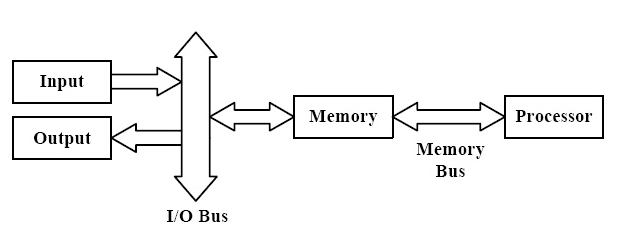Bus Structure
A “bus structure” refers to the arrangement and organization of buses within a computer system. The bus structure defines how these buses are interconnected and how they facilitate data transfer and control within the system.
There are many ways to connect different parts inside the computer together. First way is Single Bus Structure and second is Multi-Bus structure.
Single Bus Structure:
In this architecture, a single shared bus is used to connect various hardware components like CPU, Memory I/O devices etc within the computer system.

Advantages of Single Bus Structure:
- Simplicity: Single bus architectures are relatively simple to design and implement, making them cost-effective for many applications.
- Cost-Efficiency: The use of a single bus reduces the complexity and cost of the hardware compared to more elaborate bus structures.
Disadvantages of Single Bus Structure:
- Limited Bandwidth: A single bus structure can become a bottleneck in terms of data transfer bandwidth, as all components share the same bus. This can limit the overall performance of the system.
- Scalability: As computer systems become more complex and require higher bandwidth for data transfer, a single bus structure may struggle to scale efficiently.
- Contention: Contention for the bus can occur when multiple components attempt to access it simultaneously, leading to delays and potential performance issues.
Single bus architectures are commonly found in simple and cost-effective computer systems, such as personal computers and small embedded systems.
Multi-Bus Structure:
Multi-bus structure is used to enhance the performance and scalability of a computer system.

Advantages of Multi-Bus Structure:
- Improved Performance: By segmenting the buses, a multi-bus structure can increase the data transfer bandwidth and reduce contention, improving overall system performance.
- Scalability: Multi-bus architectures are more scalable than single bus architectures. As the system’s complexity grows, additional buses can be added to accommodate more devices and higher data transfer rates.
- Reduced Bus Contention: With dedicated buses for specific purposes or peripheral devices, bus contention is minimized, resulting in smoother and more efficient data transfers.
- Specialized Communication: I/O buses allow for specialized communication between the CPU and peripheral devices, optimizing data exchange for specific tasks like graphics rendering or data storage.
Disadvantages of Multi-Bus Structure:
- Complexity: Multi-bus structures are more complex to design and implement than single bus structures, which can increase system cost and complexity.
- Higher Hardware Costs: The use of multiple buses may require additional hardware components, increasing the overall cost of the computer system.
Multi-bus structures are often found in high-performance computing systems, workstations, and servers.
0 Comments